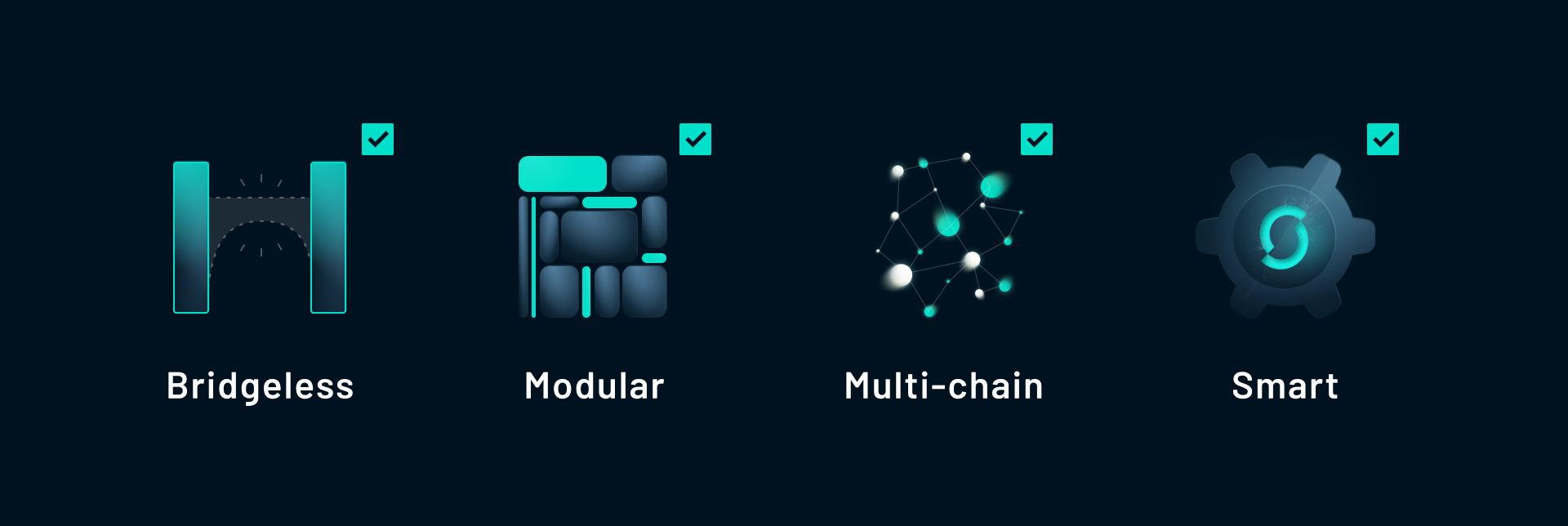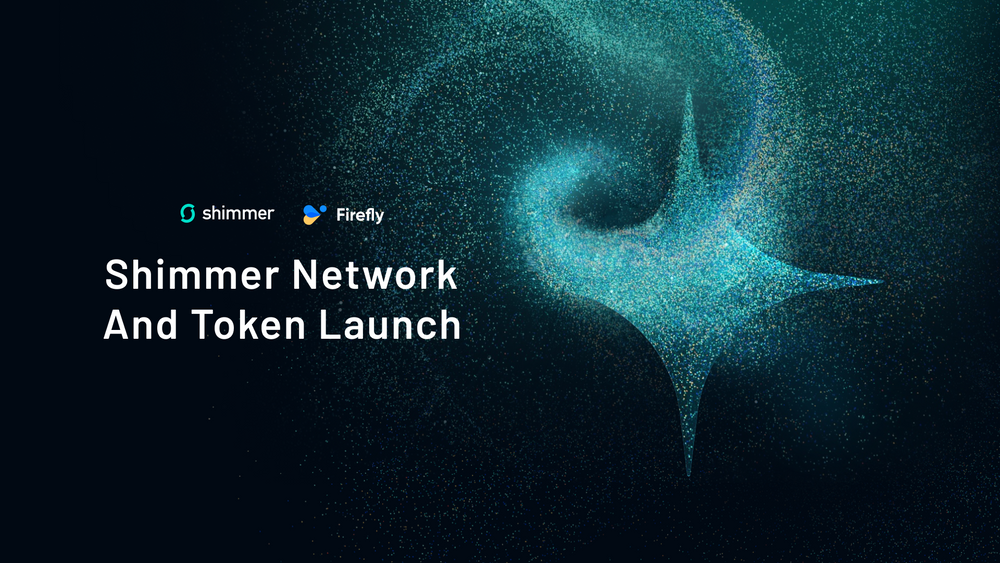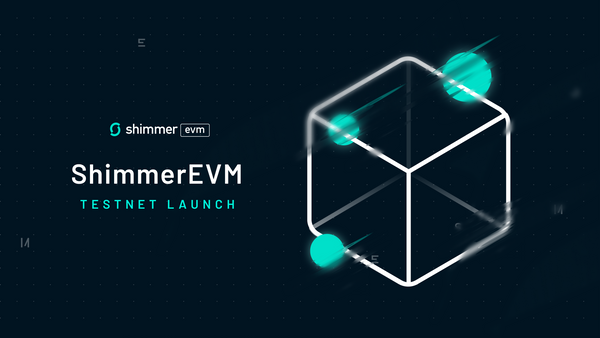Shimmer Network and Token Launch
A Multi-Chain Future on a Feeless DAG
TL;DR:
After more than two months of battle testing the Shimmer Beta version, today sees the official launch of the Shimmer network. Shimmer extends the DAG ledger with a composable tokenization framework, opening up new possibilities to tokenize everything (NFTs, real-world assets, stablecoins, fan tokens, etc.) natively on Layer 1 without fees. This framework is the foundational basis for Shimmer’s smart contract execution layer, which includes full EVM compatibility with the upcoming ShimmerEVM launch. ShimmerEVM will be the first network to start forming a multi-chain ecosystem based on the feeless, parallelized DAG ledger of Shimmer. With the completion of the fair token distribution earlier this year, where 100% of the SMR tokens were distributed to the community, SMR token holders are today able to claim their tokens using the Firefly wallet. Major exchanges have signaled integration of SMR trading pairs, with Bitfinex being the official launch partner for SMR tokens.
The Shimmer network is the staging network of the IOTA ecosystem. Any core protocol improvements and feature upgrades are made available on Shimmer first, to help test, validate and expedite IOTA's engineering roadmap. Today, this is signified by the launch of the new protocol and its tokenization framework (called "Stardust" internally) while, later, IOTA 2.0 and its leaderless consensus will debut on Shimmer.
Always being the first to receive the latest features makes Shimmer the ideal innovation ground to provide new opportunities for early participants. With its native \$SMR token, Shimmer will be its own Layer 1 network and will foster a dApp ecosystem. It is focused on creating value for the community by building new token and smart contract use cases. Before the launch, many dApps are already awaiting deployment on Shimmer. A test version of a public smart contract chain connected to the Shimmer Beta Network has recently been published, allowing testing integrations for release.
Once feature-complete with the upcoming ShimmerEVM launch, the Shimmer network will be amongst the smart contract networks with the lowest fees for smart contract execution, offering builders a network of new opportunities to build and scale their decentralized applications:
- Highly scalable ledger. The DAG ledger of Shimmer is UTXO-based and able to scale to higher transaction throughput with fast finality times (five seconds) than conventional Layer 1 blockchains. State anchoring of connected smart contract blockchains (Layer 2) is parallelized, allowing the networks to scale horizontally. Transactions on Layer 1 are feeless and highly optimized for low resource usage.
- Native assets. You can create, mint, and transfer assets natively on the protocol (Layer 1) without any fees. These assets are in your control and don’t rely on someone else’s smart contract chain. They can be freely and frictionlessly transferred to all chains and layers of the network.
- Application layer with EVM and WASM support. Shimmer is a feature-rich smart contract platform that offers builders the choice to build dApps on EVM and/or WASM-enabled smart contract blockchains (Layer 2). Such a blockchain network can also support multiple, different VMs in parallel, allowing entirely new dApps and Web3 ecosystems to be created.
- Bridgeless composability. Bridgeless native asset transfers across the entire Shimmer ecosystem, including between sovereign blockchain networks anchored on Shimmer, which frees up liquidity to move quickly between chains without trust assumptions or transaction fees and is secured by the entire Layer 1 ledger instead of a smart contract bridge operator.
- MEV protection and native randomness. Shimmer smart contract chains remove current network limitations such as front-running or sandwich attacks. The native randomness beacon is freely available to all dApps in the ShimmerEVM, removing the dependency on expensive trusted third parties and oracles.
- Fair token distribution. In one of the very few fair token distributions in the crypto space, all Shimmer tokens have been distributed to the community. No VCs, no token lock-ups, and no hidden token allocations to the team. Shimmer is a community-owned network focused on building a long-term, sustainable ecosystem with incentives and opportunities aligned between all participants.

A bridgeless, modular, multi-chain smart contract architecture
The Stardust protocol and its tokenization framework is the most crucial element of Shimmer, enabling a horizontally scalable and modular multi-chain architecture that allows sovereign smart contract networks to be processed in parallel while retaining composability across chains.
Many Layer 1 networks allow the deployment of multiple smart contract chains on top of them. But in doing so, all of them suffer from fractionalization. If chains cannot interact with one another, they remain tiny little bubbles with little to no means to interact with other networks. To allow chains to interact, dedicated bridges are built between them, but this approach has three major drawbacks:
- Resources: Every bridge between two networks has to be built, audited, and maintained individually. If a chain wants to interact with 20 other chains, it has to build, audit, and maintain 20 individual bridges. That is a lot of effort and very, very expensive.
- Security: Bridges contain a lot of value and are therefore one of the highest-valued targets for hackers. All bridges are based on smart contracts and as such rely on how well these contracts have been written and audited. Hardly a week goes by without a bridge being compromised, resulting in billions of lost user funds over the years.
- Fees: Bridges are a service provided by profit-oriented actors. Using bridges always cost fees, which are sometimes prohibitively high.
In our constant striving to overcome such drawbacks, we have decided on another approach. As you might have heard already, Shimmer’s tokenization framework allows anyone to mint, manage, melt or burn custom Layer 1 tokens and NFTs.
Minting such native tokens is feeless, only requiring a minuscule, fully refundable deposit in \$SMR tokens that is locked up as long as an asset exists. User-defined native tokens and NFTs inherit the same characteristics and security features as the network’s native \$SMR token, which makes them much safer than any token generated through a potentially exploitable smart contract in a Layer 2 network.
Because they are easy to create, feeless, and more secure than smart contract-based assets, native Layer 1 assets are the perfect vessel to transfer value between smart contract chains. Just as users are able to mint their own tokens, smart contract chains anchored to the Shimmer network can also mint customizable native tokens.
Every smart contract chain anchored to the Shimmer network is in control of addresses on the Shimmer network. Through Shimmer's native assets framework, sovereign smart contract chains can wrap any asset into a newly minted token on the Layer 1 Shimmer network and transfer them – for example, to an address controlled by another smart contract chain. This way, value can be transferred from one smart contract chain to another, enabling frictionless trade in a multi-chain network, without the need to build, audit, and maintain any dedicated bridges. As minting and transferring do not incur a fee, the operational cost is close to zero.
A base layer for bridgeless value transactions in a multi-chain environment now exists. With Shimmer, everyone can participate in a new token economy and be empowered to create, mint, and transfer native assets in a secure, frictionless and feeless manner. Only when minting native assets on Shimmer are you truly in control of your assets, as there are no middlemen or smart contract implementations responsible for the bookkeeping – all assets are secured and represented natively in the Layer 1 protocol. Next, we will deploy the first smart contract chain, ShimmerEVM, opening up limitless token utility and new possibilities through smart contracts to the community.
The \$SMR Token
The \$SMR token is the native token of the Shimmer network. It is the asset any connected smart contract chain automatically has access to and as such represents the base currency of the whole multi-chain architecture. The \$SMR token can be used to settle execution fees on smart contract chains, as is the case in the upcoming ShimmerEVM chain. In addition, the \$SMR token is used in storage deposits when minting native assets or NFTs on the Shimmer network.
The Shimmer token was fairly distributed, with 100% of the initial token supply going to the community. Anyone staking IOTA tokens received \$SMR tokens over a three-month staking period. During that time, a total of ~1,450,896,407 SMR was generated from users staking IOTA. Moreover, the community decided to mint additional tokens to award 10% of the total supply (~181,362,051 \$SMR) each to the Swiss Tangle Ecosystem Association (TEA) and the Shimmer Community Treasury (DAO), allowing them to independently fund community projects. The total Shimmer supply is ~1,813,620,509 \$SMR (equaling 1,813,620,509,061,365 “glow”, the smallest denomination of \$SMR).
Claiming \$SMR Tokens
By importing stronghold backup files, BIP39 24-word phrases, or hardware wallet devices of the account from which IOTA tokens have been staked in the IOTA network, users can claim their \$SMR tokens in the Shimmer network. In essence, airdropped tokens have been allocated to the same addresses, but in another network. By using their keys from the IOTA network in the Shimmer network, users can access their \$SMR tokens on the Shimmer network (in case anyone wonders: signature reuse across networks is not possible because of the replay protection mechanism implemented in the Stardust protocol). Even though the whole claiming process is a breeze and pretty much self-explanatory when using the Firefly wallet, we have provided a step-by-step guide to claim tokens for your convenience here.
Treasury addresses
The community-verified Shimmer Genesis snapshot allocates 10% of the total token supply to each of the following treasury addresses:
Shimmer Community Treasury (DAO): smr1qrmakyqt5ezm5k9c0sk39gwfavpktxkjmx0jvh9ejxjq6pr6d39egv2mvuc
Swiss Tangle Ecosystem Association: smr1qpjva0y6qwjmv42dspw2se2776l5qr0r5p2s5m7nrg73qhvm6a6y7uvqxn6
Once the community has established the Community Treasury DAO structure and its governance through a vote, the tokens will be handed over to the community treasury. As this will require smart contracts to govern the funds, the IOTA Foundation will hold the community token allocation until the technology and the community is ready to take ownership of them.
Public Shimmer infrastructure
We have developed several open-source products and tools for Shimmer that everyone is encouraged to use, deploy and contribute to:
- Hornet, the easy-to-use node software is the official network client powering Shimmer.
- Chronicle serves as the historical network data retention tool that also provides analytics capabilities. It’s a powerful backend for any explorer implementation.
- Several node extension plugins are available for specific use cases, such as indexing, event streaming, decentralized voting, or data inclusion proofs.
- Client libraries for interacting with the network are supported in a variety of languages.
- Wallet libraries are available in a handful of languages and help developers to quickly integrate Shimmer into any application. Our Exchange Integration Guide walks you through the convenient steps of setting up the library for projects that want to enable \$SMR trading pairs. A command line wallet eases the burden of application testing.
- Wasp, the node software for running Layer 2 smart contract chains (a.k.a. blockchains) on top of Shimmer, is still in the beta testing phase. Its full release is expected to happen with the ShimmerEVM launch.
The IOTA Foundation provides a public infrastructure to access and interact with the Shimmer network. There are also several community-maintained entry points into the network.
The official entry points into Shimmer are:
- Shimmer Explorer
- Firefly Wallet
- Public, load-balanced Node API: https://api.shimmer.network
- Public, load-balanced Chronicle API: https://chronicle.shimmer.network
- Developer Documentation
Coming next to Shimmer
As described, the tokenization framework of the Shimmer network provides the foundation for a modular multi-chain architecture. Following the publication of our exchange integration guidelines, we have been in contact with some of the largest exchanges, helping them to integrate Shimmer. At least one of them plans to list Shimmer in the coming days.
Following the release of the Shimmer network will be the release of the ShimmerEVM chain, the first public smart contract chain anchored to Shimmer. The ShimmerEVM will complete the Shimmer network by adding modular smart contract capability to the architecture.
An early version of the ShimmerEVM chain already exists in the form of a public test chain which can be used by developers to test their integrations before the ShimmerEVM chain is launched. More information about Stardust-protocol compatible smart contracts can be found in this article.
Pending further testing and optimization, we expect the release version of the ShimmerEVM chain to go live in just a few weeks. Needless to say, we take safety and security first, and will only launch the ShimmerEVM after the extensive testing phase has successfully been completed.
Following the release of the Shimmer network, we will also start integrating Coordicide modules, porting over the fully decentralized consensus algorithm that has been tested for nearly a year on the IOTA 2.0 DevNet.
Any of the modules that have been integrated into Shimmer will be integrated into IOTA, after having been thoroughly tested on the Shimmer network.
Today
We are incredibly happy that Shimmer has finally launched and are looking forward to projects launching on the mainnet. In the meantime, we will continue to improve the documentation and prepare for the launch of the ShimmerEVM, which we expect in a few weeks. If you want to learn more, check out the documentation. As always, please also feel free to chat with us on our Discord.
Links in this article
- Website: Shimmer.network
- Discord: Shimmer Discord Channel
- Article: Shimmer Beta network launch
- Article: Stardust Tokenization Framework in a Nutshell
- Article: Stardust Tokenization Framework Deep dive
- Article: Shimmer Token Fair Launch Through Staking
- Article: Hornet Node for Shimmer beta network
- Article: Community Decision to Increase the Token Supply to Form Ecosystem Fund
- Article: Stardust Protocol-compatible Smart Contracts
- Article: Public Smart Contract testnet launch
- Link: Shimmer Network Explorer
- Link: List of registered Ecosystem dApps planning to launch on Shimmer
- Link: Fully decentralized IOTA2.0 DevNet
- Wallet: Firefly for Shimmer Download
- Wiki: Wiki Shimmer Dokumentation
- Wiki: Exchange Integration Guidelines
Follow us on our official channels for all the latest Shimmer news:
Discord | Twitter | LinkedIn | Reddit


